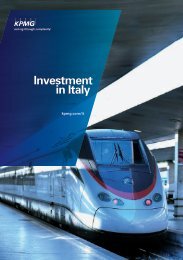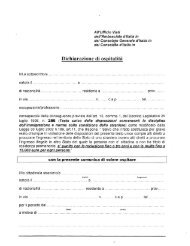<strong>Innovation</strong> <strong>Canada</strong>: A <strong>Call</strong> <strong>to</strong> <strong>Action</strong>Figure 2.2 Sources of <strong>Canada</strong>–US Gap in Average Annual Labour Productivity Growth(differences in percentage growth rates: <strong>Canada</strong> minus the US) a1961–2008 1961–1980 1980–2000 2000–2008Gap in labourproductivitygrowth -0.3 0.4 -0.4 -1.9(i) Capitaldeepening 0.4 0.8 0.2 0.1(ii) Workforcecomposition 0.2 0.4 0.1 0.1(iii) Multifac<strong>to</strong>rproductivity -0.9 -0.9 -0.6 -2.1aThe numbers in the first line of the table — the difference between <strong>Canada</strong> and the US in average annual labourproductivity growth — are equal <strong>to</strong> the sum of lines (i) through (iii), which decompose the productivity growth gap in<strong>to</strong>components related <strong>to</strong> capital intensity, workforce composition and MFP (subject <strong>to</strong> rounding).Source: Baldwin and Gu (2009).that <strong>Canada</strong>’s productivity growth problemis due <strong>to</strong> persistently weak MFP growth,particularly during the past decade (Baldwinand Gu 2009; also see Figure 2.2). Although amultiplicity of fac<strong>to</strong>rs is involved, longer-termMFP growth trends reflect the pace of businessinnovation (CCA 2009, pp. 36–44). It followsthat <strong>Canada</strong>’s subpar productivity growth islargely attributable <strong>to</strong> relatively weak businessinnovation. (There are of course a great manyhighly innovative Canadian businesses but,relative <strong>to</strong> many other advanced countries,they play a proportionally smaller role in<strong>Canada</strong>’s economy.)<strong>Innovation</strong> and R&DInvestment by businesses in R&D is a key input<strong>to</strong> many kinds of innovation (Box 2.2). In viewof the relatively weak R&D spending byCanadian businesses (Box 2.3), it is notsurprising that MFP growth has also been weak.The great majority of business R&D isundertaken <strong>to</strong> support defined marke<strong>to</strong>bjectives and is thus at the “development” endof the R&D spectrum. (Activities characterizedas “experimental development” make up about80 percent of business R&D spending in<strong>Canada</strong>; see Statistics <strong>Canada</strong> 2009.) Althoughthe business sec<strong>to</strong>r accounts for a much smallerpercentage of <strong>to</strong>tal R&D in <strong>Canada</strong> than incountries such as the US, Germany, Japan orSweden, business is nonetheless the largestR&D performer in the country, accounting formore than 50 percent of the <strong>to</strong>tal (OECD 2011).2-4
The Context of the ReviewBox 2.2 Defining R&DThe Frascati Manual (OECD 2002), first published in 1963, is the basis for the OECD’sdefinition of R&D, which emphasizes the creation and novel use of knowledge. Themeasurement of R&D expenditure includes both current costs (labour costs and non-capitalpurchases of materials, supplies and equipment) and capital costs (land and buildings,instruments and equipment, and computer software) devoted <strong>to</strong> R&D, which covers threeactivities:Basic research is experimental or theoretical work undertaken primarily <strong>to</strong> acquire newknowledge of the underlying foundation of phenomena and observable facts, withoutany particular application or use in view. Applied research is also original investigationundertaken in order <strong>to</strong> acquire new knowledge. It is, however, directed primarily<strong>to</strong>wards a specific practical aim or objective. Experimental development is systematicwork, drawing on existing knowledge gained from research and/or practical experience,which is directed <strong>to</strong> producing new materials, products or devices, <strong>to</strong> installing newprocesses, systems and services, or <strong>to</strong> improving substantially those already produced orinstalled. (OECD 2002, p. 30)The annual spending on R&D performed by a country’s business sec<strong>to</strong>r is referred <strong>to</strong> as BERD(business expenditure on R&D), while that performed by the higher education sec<strong>to</strong>r isreferred <strong>to</strong> as HERD (higher education expenditure on R&D). Reference is often made <strong>to</strong>“BERD intensity” or “HERD intensity,” defined as the value of BERD or HERD expressed as aproportion of gross domestic product (GDP).In the above definition of R&D, the emphasis on knowledge creation and novel use hasimportant implications for the classification of scientific activities as “R&D” as distinct from“scientific or technological services.” For example, the search for reserves of oil and gasqualifies as R&D only if new survey methods or techniques have been developed <strong>to</strong>undertake the search. Similarly, explora<strong>to</strong>ry drilling is not R&D, but there may be caseswhere the development of new drilling methods or techniques would qualify as R&D.While the definition of R&D has remained unchanged since the first edition of the FrascatiManual, its methodological guidelines have expanded and now include greater attention <strong>to</strong>the measurement of R&D in services. The Frascati Manual is accepted by consensus of allOECD countries, thus ensuring international agreement on the definition of R&D, as well asthe application of guidelines for its measurement. There is nevertheless still some room fornational differences of interpretation as well as variation in the depth and specificity ofdata collected by statistical agencies for indica<strong>to</strong>rs such as HERD and BERD. So while OECDdata allow for meaningful international comparisons of R&D activity, perfect cross-nationalcomparability remains an aspiration and not yet a reality.2-5
















